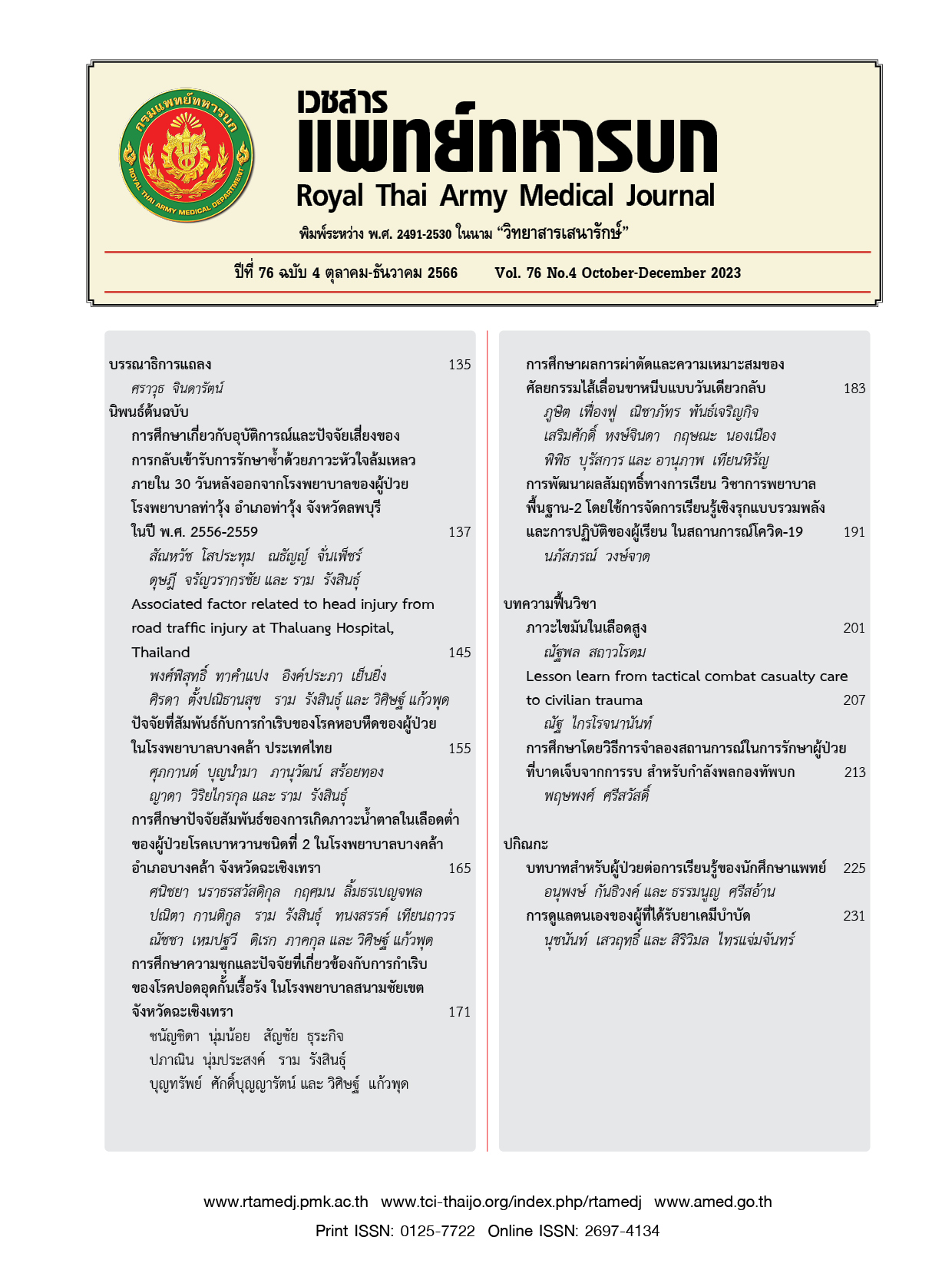การพัฒนาผลสัมฤทธิ์ทางการเรียน วิชาการพยาบาลพื้นฐาน-2 โดยใช้การจัดการเรียนรู้เชิงรุกแบบรวมพลังและการปฏิบัติของผู้เรียน ในสถานการณ์โควิด-19
Main Article Content
บทคัดย่อ
ความเป็นมา การจัดการเรียนรู้วิชาการพยาบาลพื้นฐาน-2 มีความสำคัญในการดูแลผู้ป่วย ด้วยเหตุผลผู้เรียนมีผลการทดสอบก่อนเรียนต่ำ จึงนำการจัดการเรียนรู้เชิงรุกแบบรวมพลังและการปฏิบัติ มาใช้แก้ปัญหาในชั้นเรียน วัตถุประสงค์ 1) เพื่อเปรียบเทียบผลสัมฤทธิ์ทางการเรียนวิชาการพยาบาลพื้นฐาน-2 หลังการจัดการเรียนรู้เชิงรุกแบบรวมพลัง และการปฏิบัติของผู้เรียนในสถานการณ์ โควิด-19 2) เพื่อศึกษาผลการปฏิบัติวิชาการพยาบาลพื้นฐาน-2 ของผู้เรียน หลังการจัดการเรียนรู้เชิงรุกรวมพลังและการปฏิบัติ ในสถานการณ์โควิด-19 เทียบกับเกณฑ์ร้อยละ 70 วิธีการศึกษา ประชากรของการวิจัยครั้งนี้คือ ผู้เรียนหมายถึงนักเรียนนายสิบทหารบก เหล่าทหารแพทย์ รุ่นที่ 25 โรงเรียนเสนารักษ์ กรมแพทย์ทหารบก ปีการศึกษา 2565 จำนวน 145 นาย เครื่องมือที่ใช้ในการวิจัย ครั้งนี้ ได้แก่ แผนการจัดการเรียนรู้ แบบทดสอบวัดผลสัมฤทธิ์ทางการเรียนและก่อนเรียน แบบทดสอบระหว่างเรียน แบบประเมิน ทักษะหัตถการ ทางการพยาบาลพื้นฐาน-2 วิเคราะห์ข้อมูลโดยใช้สถิติเชิงพรรณนา และสถิติเชิงอนุมาน ได้แก่ ค่าร้อยละ ค่าเฉลี่ย ค่าเบี่ยงเบนมาตรฐาน การวิเคราะห์ความแตกต่างผลสัมฤทธิ์ทางการเรียนกับคะแนนสอบก่อนเรียน ใช้ค่า t-test dependent กำหนดค่านัยสำคัญทางสถิติที่ระดับน้อยกว่า 0.05 ผลการวิจัย พบว่าผลสัมฤทธิ์ทางการเรียนสูงกว่าคะแนนก่อนเรียน อย่างมีนัยสำคัญทางสถิติที่ระดับน้อยกว่า .05 (p = 0.00) ผลการศึกษา การปฏิบัติวิชาการพยาบาลพื้นฐาน-2 มีค่าเฉลี่ยร้อยละ 86.87 (สูงกว่าเกณฑ์ร้อย ละ 70) ค่าเบี่ยงเบนมาตรฐาน 0.51 สรุป งานวิจัยนี้แสดงให้เห็นผลลัพธ์ของผลสัมฤทธิ์ทางการเรียน มีความสัมพันธ์กับการจัดการเรียนรู้เชิงรุกแบบรวมพลังและการปฏิบัติ
Downloads
Article Details

อนุญาตภายใต้เงื่อนไข Creative Commons Attribution-NonCommercial-NoDerivatives 4.0 International License.
บทความในวารสารนี้อยู่ภายใต้ลิขสิทธิ์ของ กรมแพทย์ทหารบก และเผยแพร่ภายใต้สัญญาอนุญาต Creative Commons Attribution-NonCommercial-NoDerivatives 4.0 International (CC BY-NC-ND 4.0)
ท่านสามารถอ่านและใช้งานเพื่อวัตถุประสงค์ทางการศึกษา และทางวิชาการ เช่น การสอน การวิจัย หรือการอ้างอิง โดยต้องให้เครดิตอย่างเหมาะสมแก่ผู้เขียนและวารสาร
ห้ามใช้หรือแก้ไขบทความโดยไม่ได้รับอนุญาต
ข้อความที่ปรากฏในบทความเป็นความคิดเห็นของผู้เขียนเท่านั้น
ผู้เขียนเป็นผู้รับผิดชอบต่อเนื้อหาและความถูกต้องของบทความของตนอย่างเต็มที่
การนำบทความไปเผยแพร่ซ้ำในรูปแบบสาธารณะอื่นใด ต้องได้รับอนุญาตจากวารสาร
เอกสารอ้างอิง
Chang-Tik C. Introduction: Collaborative Active Learning - strategies, Assessment and Feedback. In: Chang-Tik C, Kidman G, Yew Tee M, editors. Collaborative Active Learning. Singapore: Springer; 2022; p. 3-31.
Goh J. In: Collaborative Learning in Informal Spaces: Formulating a Pedagogical Project of Student-Centred Active Learning in Gender Studies. In: Chang-Tik C, Kidman G, Yew Tee M, editors. Collaborative Active Learning. Singapore: Springer; 2022; p. 105-30.
Kidman G, Nguyet Nguyen M. Active Learning: An Integrative Review. In: Chang-Tik C, Kidman G, Yew Tee M, editors. Collaborative Active Learning. Singapore: Springer; 2022. p. 33-52.
Chang-Tik C. Student Collaboration Through Assessment, Feedback and Peer Instruction. In: Chang-Tik C, Kidman G, Yew Tee M, editors. Collaborative Active Learning. Singapore: Springer; 2022. p. 53-79.
Le H, Janssen J, Wubbels T. Collaborative learning practices: teacher and student perceived obstacles to effective student collaboration. Camb J Educ. 2018;48(1):103-22.
Erkens M, Bodemer D. Improving collaborative learning: Guiding knowledge exchange through the provision of information about learning partners and learning contents. Compt Educ. 2019;128: 452-72.
Soller A, Lesgold A. Collaborative Tools in Educational Practice. In: Ulrich Hoppe H. Ogata H, Soller A, Editors. The Role of Technology in CSCL. New York: Springer; 2023. p 117-20.
Wongpratoom W, Sranamkam T. The Effects of Blended Learning Using Collaborative Learning with Student Team Achievement Divisions (STAD) Technique to Enhance Analytical Thinking for Grade VII Students. Int J Learn Teach. 2019;5(4):280-4.
Scager K, Boonstra J, Peeters T, Vulperhorst J, Wiegant F. Collaborative Learning in Higher Education: Evoking Positive Interdependence. CBE Life Sci Educ. 2016;15(4):1-4.
Fung D, Hung V, Wai-mei L. Enhancing Science Learning Through the Introduction of Effective Group Work in Hong Kong Secondary Classrooms. Int J Sci Math Educ. 2018;16:1291-314.


